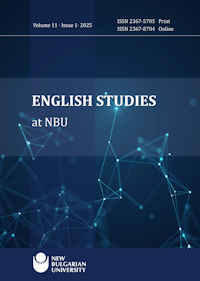Rethinking genetic borders in ‘The Hunger Games’
DOI:
https://doi.org/10.33919/esnbu.25.1.5Abstract
Emphasizing the fading distinction between reality and artificiality due to the innovations in the fields of science and biotechnology, this paper argues that the fantasy world depicted by science fiction is no longer far from today’s reality. Although technological advancements have enabled us to live more comfortably, when they are misused by those seeking to use them as a sign of power or superiority, they can have disastrous effects on both people and the environment. This study explores how an oppressive regime called Capitol in The Hunger Games employs science and technology to transform animals and humans into commodities within the arena, reducing them to instruments of entertainment. The Games’ intentional replacement of natural beings with biotechnological mutations serves as a deliberate display of power, employing genetically engineered species as weapons and reviving the dead as monsters. This not only captivates the audience but also strengthens the regime’s superiority, exemplifying how technology is weaponized to manipulate both fear and entertainment.
References
Baudrillard, J. (1994). Simulacra and Simulation. University of Michigan Press. https://doi.org/10.3998/mpub.9904 DOI: https://doi.org/10.3998/mpub.9904
Best, S. & Kellner, D. (2001). The Postmodern Adventure: Science, Technology, and Cultural Studies at the Third Millennium. Guilford Press.
Bohm, D. (1980). Wholeness and the Implicate Order. Routledge & Kegan Paul.
Collins, S. (2008). The Hunger Games. Scholastic Press.
Curry, A. (2013). Environmental Crisis in Young Adult Fiction: A Poetics of Earth. Palgrave Macmillan. https://doi.org/10.1057/9781137270115 DOI: https://doi.org/10.1057/9781137270115
Day, H. (2012). Simulacra, Sacrifice and Survival in The Hunger Games, Battle Royale, and The Running Man, In M. F. Pharr & L. A. Clark (Eds.), Of Bread, Blood and The Hunger Games: Critical Essays on the Suzanne Collins Trilogy (pp. 167-178), McFarland.
Graham, E. (2002). Representations of the Post/Human: Monsters, Aliens and Others in Popular Culture. Manchester University Press.
Green-Barteet, M. A. (2014). I’m Beginning to Know Who I Am: The Rebellious Subjectivities of Katniss Everdeen and Tris Prior. In S. K. Day, M. A. Green-Barteet & A. L. Montz (Eds.), Female Rebellion in Young Adult Dystopian Fiction (pp. 33–50). Ashgate.
Hegel, G. W. F. (1998). Phenomenology of Spirit. Motilal Banarsidass.
Henthorne, T. (2012). Approaching the Hunger Games Trilogy: A Literary and Cultural Analysis. McFarland & Co. Publishers.
Jameson, F. (2005). Archaeologies of the Future: The Desire Called Utopia and Other Science Fictions. Verso.
Johnston, J. O. (2021). Posthuman Capital and Biotechnology in Contemporary Novels. Palgrave Macmillan. https://doi.org/10.1007/978-3-030-78833-9 DOI: https://doi.org/10.1007/978-3-030-78833-9
Leopold, A. (1989). A Sand County Almanac, and Sketches Here and There. Oxford University Press.
Naess, A. (2003). Ecology, Community and Lifestyle: Outline of an Ecosophy (D. Rothenberg, Trans.). Cambridge University Press
Ostry, E. (2004). Is He Still Human? Are You?: Young Adult Science Fiction in the Posthuman Age. The Lion and the Unicorn, 28(2), 222–246. https://doi.org/10.1353/uni.2004.0024 DOI: https://doi.org/10.1353/uni.2004.0024
Plumwood, V. (2002). Environmental Culture: The Ecological Crisis of Reason. Routledge.
Žižek, S. (2008). In Defense of Lost Causes. Verso.
Downloads
Published
How to Cite
Issue
Section
License
Copyright (c) 2025 Kevser Ateş

This work is licensed under a Creative Commons Attribution-NonCommercial 4.0 International License.
Access Policy and Content Licensing
All published articles on the ESNBU site are licensed under the Creative Commons Attribution 4.0 International License (CC BY 4.0). This license permits unrestricted use, distribution, and reproduction in any medium, provided the original work is properly cited. It allows reusers to distribute, remix, adapt, and build upon the material in any medium or format, even for commercial purposes. The terms on which the article is published allow the posting of the published article (Version of Record) in any repository by the author(s) or with their consent.
Note that prior to, and including, Volume 10, Issue 2, 2024, articles were licensed under the Non-commercial (CC BY-NC 4.0) license. The transition to CC BY 4.0 is effective as of Volume 11, Issue 1, 2025.
In other words, under the CC BY 4.0 license users are free to
Share — copy and redistribute the material in any medium or format for any purpose, even commercially.
Adapt — remix, transform, and build upon the material for any purpose, even commercially.
Under the following terms:
Attribution (by) - You must give appropriate credit (Title, Author, Source, License), provide a link to the license, and indicate if changes were made. You may do so in any reasonable manner, but not in any way that suggests the licensor endorses you or your use.
No additional restrictions — You may not apply legal terms or technological measures that legally restrict others from doing anything the license permits.
Notice: No warranties are given. The license may not give you all of the permissions necessary for your intended use. For example, other rights such as publicity, privacy, or moral rights may limit how you use the material.
If the law requires that the article be published in the public domain, authors will notify ESNBU at the time of submission, and in such cases the article shall be released under the Creative Commons Public Domain Dedication waiver CC0 1.0 Universal.
Copyright
Copyright for articles published in ESNBU are retained by the authors, with first publication rights granted to the journal. Authors retain full publishing rights and are encouraged to upload their work to institutional repositories, social academic networking sites, etc. ESNBU is not responsible for subsequent uses of the work. It is the author's responsibility to bring an infringement action if so desired by the author.
Exceptions to copyright policy
Occasionally ESNBU may co-publish articles jointly with other publishers, and different licensing conditions may then apply.






